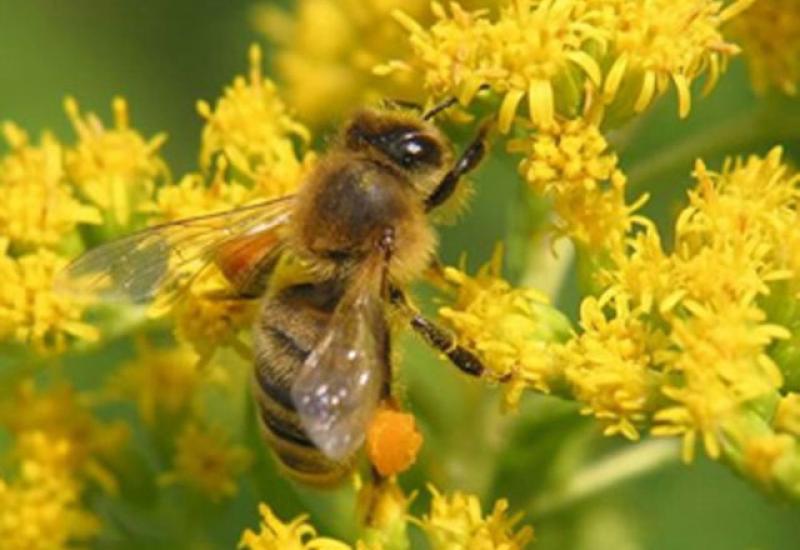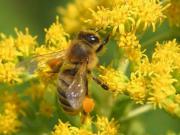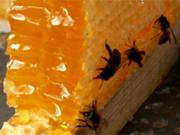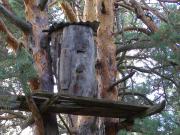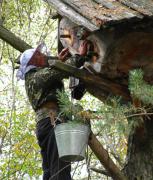Autumn honey fairs have become commonplace for us. Making gratitude to little winged toilers, we store this sunny nectar for the winter. But it turns out that in addition to cultural beekeeping, which is widespread in Ukraine to this day, there is a unique form of bee-keeping, the wild one, which is preserved in its original form from the time of Kievan Rus. In Polessky Nature Reserve there is a small village Selezovka, where almost all the inhabitants are collecting forest honey. It is hypoallergenic and very much appreciated by consumers. (there is also such bee-keeping in Bashkiria.)
From the history of wild beekeeping
Our East Slavic ancestors were actively and successfully engaged in extracting the honey of wild bees that lived in tree hollows. With the forest honey and they paid tribute to Kiev and other authorities. For convenience the Polishchuks (residents Polesie) made artificial hollows in living trees (the wild bee hives). On the coats of arms of many cities there were pictured the wild bee-hive or bee. Even some 50 years ago in the north Olevskii District (Zhytomyr region) one could meet the real, hollowed out in the pines bee hives. Now some oaks with such honey cameras one can be found in the floodplain Ubort, but the bees do not live there. However, now almost there are no trees big enough to make a good hollow. Therefore, the locals use artificial bee hives, which they adjusted on the trees. They called them kadubki, but more often the wild bee hive, and those involved in extracting the honey of them, as in ancient times are named Bortniky (bee keepers of wild bee).
Wild hives these are the hives made from wood-blocks
They are made from old trees with a diameter of 50 cm. One can do up to five wild hives from one 1.5-meter champ. The most suitable are the old pines with rotten core and a porous wall thickness of 10 cm. The upper part of the wild hive is named the "head", the bottom - "leg". There is between them the hole – beehive entrance. On the opposite side if is adjusted the longitudinal strap on pegs closing vertically slotted honey chamber, where the bees build their honeycombs. In a thick dry hive, weighing more than 100 kg, bees can easily withstand frosts and summer heat. Today beekeeper has an average of 20-30 suitable for beekeeping wild hives. Normally, the half of them is populated with bee families.
In old times, the age of wild hive could reach 100 years. They served several generations of the family, handed down from generation to generation. Often beehives were mounted on large trees (on branches or wooden spokes, reinforcing them with iron brackets at a height of 10-20 m). The top was covered with stab boards or slate. Tree, where a bee colony lives, is called "stall" and much appreciated, because sometimes one need wait for years shifting hives from one tree to another, until it will be inhabited by bee’s tribe.
Over time, the hives become unsuitable for bees. The rodents, birds settle in them. On the roof black storks and great gray owl - rare species listed in the Red Book of Ukraine and Belarus- make their nestles on the beehives’ roof.
About bees
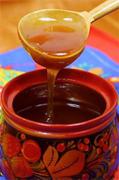 Today beekeepers have mostly Carpathian, Caucasian or Ukrainian bees, which are working in the human exploration of the landscape. Wild honeybees have survived thanks to the efforts wild beekeepers. Bees from Polessie are going through hard natural selection and are a valuable genetic material for breeding disease-resistant, winter-hardy species. Wild wooly bees are an essential element of forest ecosystems. Pollinating plants, they play an important role in the life of the forest, and beekeeping is a valuable cultural heritage of our people.
Today beekeepers have mostly Carpathian, Caucasian or Ukrainian bees, which are working in the human exploration of the landscape. Wild honeybees have survived thanks to the efforts wild beekeepers. Bees from Polessie are going through hard natural selection and are a valuable genetic material for breeding disease-resistant, winter-hardy species. Wild wooly bees are an essential element of forest ecosystems. Pollinating plants, they play an important role in the life of the forest, and beekeeping is a valuable cultural heritage of our people.
"Мені кілька разів доводилося вибирати мед з таких вуликів, – розповідає Сергій Жила, директор Поліського заповідника. – Враження не із приємних, коли висиш попід хмарами на непевній вузькій дощечці. Дерево хитається від вітру, бджоли лізуть в очі і раз по раз жалять. Обидві руки по лікті в меду, а на думку спадає дідівська "статистика" про бортників, які розбилися або покалічилися".
Основний взяток меду у поліських лісах бджоли беруть з крушини та вересу. Вибирають мед з бортей один раз на рік – на початку осені, коли бджоли не дуже активні. Одна борть приносить в середньому 10-20 кг меду на рік. Бортьовий мед – безцінний продукт, адже медові стільники не відокремлюють від пергових, тож вони поєднують у собі корисні властивості усіх продуктів бджільництва: воску, прополісу, пилку, перги тощо. Така суміш додає людині життєвих сил, знімає слабкість, зміцнює дух.
How the honey is extracted
Before the wild hives were fastened at a higher altitude than now, to make it difficult for bears (and not only bears) to reach them. To protect against bears there were used pilings, arbalests and other devices. Effective mean was tied near the hive a wooden log. Bear climbed up a tree to the hive, ran across the log and tried to push it with a paw. In the end, the angry bear let the tree trunk to grab the log by two feet, and fell down. The men climbed up a tree by a gnarled trunk of a pine, which in Polesie called spear, or a special rope-plus and loops, called "lezivo."
"Several times I had to collect the honey from these hives - says Sergey Zhila, director of the Polesie reserve. - Impressions are far from pleasant when you are hanging in the sky on a narrow uncertain plank. The tree sways in the wind, bees crawl into my eyes now and then sting. Both hands stained with honey and grandfather’s "statistics" comes to mind about many wild beekeepers crashed or maimed. "
The main part of honey bees in Polesie forests take from buckthorn and heather. The honey from the hives is collected once a year - in early autumn, when the bees are not very active. One bee-tree brings an average of 10-20 kg of honey per year. Wild-hive honey is an invaluable product, because the honeycomb is not separated from the beebread, so they combine the beneficial properties of bee products: beeswax, propolis, pollen and the like. This mixture adds human vitality, relieves fatigue, and strengthens the spirit.
N.Vdovenko

